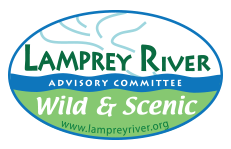The Lamprey River Curriculum
SUPPLEMENT FOR MIDDLE AND HIGH SCHOOL CLASSES
by Emma L. Rous, retired teacher
Oyster River High School, Durham, New Hampshire, 2000
revised and updated 2012, by
S. Petersen, Lamprey Rivers Advisory Committee
INTRODUCTION
The Lamprey River Curriculum was written to complement the eighteen-minute film, River Story: The Lamprey Through History. The focus of the film is the interaction of the river and the people who have lived near it, with a secondary emphasis on the natural history of the river. A theme for this curriculum might be, "The river works for the people and the people work for the river." The following ideas for using the film in middle and high school build on the curriculum designed for elementary schools. Teachers should refer to the elementary portion of the curriculum in using this guide. Specific lesson references to the elementary curriculum are included in the following material.
The study of a watershed, such as the Lamprey River's, offers an ideal vehicle for an interdisciplinary study of natural and social history in order to help students gain a deeper awareness of their immediate community and a basic understanding of the ecological connectedness of people and their natural environment. Because the Lamprey is a local resource, students can learn through first-hand experience. The role of the teacher is to facilitate experiences in which students observe, solve problems, research, and analyze.
The lessons build from general concepts about watersheds and changing points of view toward natural resources to specific activities such as mapping the Lamprey, keeping a journal, viewing the film, conducting research, engaging in art projects, taking a field trip to the river, and addressing problems with present and future stewardship of the river. Teachers using the whole curriculum will introduce journals, then start with "Background Activities," view the film, and divide the class into research project groups. The field trip, monitoring activities, and artistic responses can be done in connection with the research projects or at any time during the unit. The unit ends with project presentations and a choice of case studies on recent and current decisions affecting the Lamprey. The material is best used as an entire unit, but individual lessons can also be effective.

